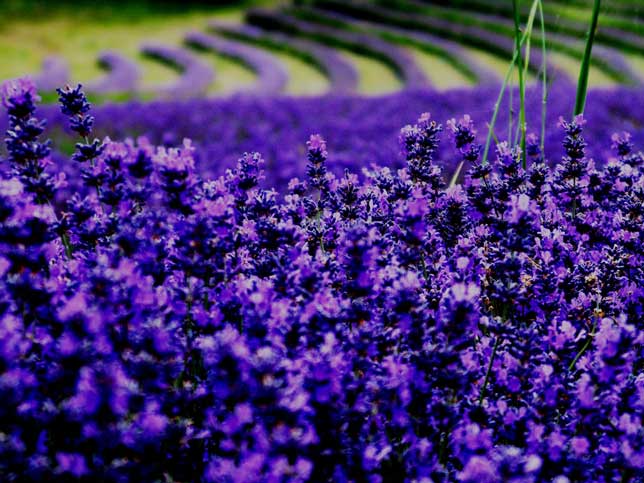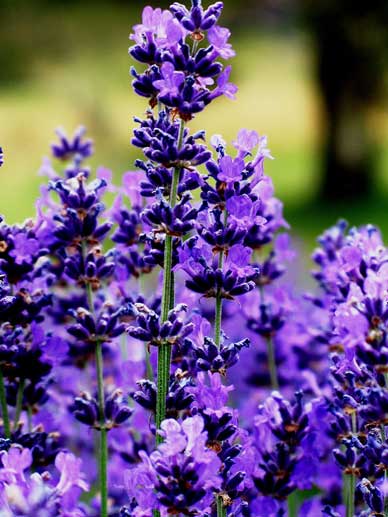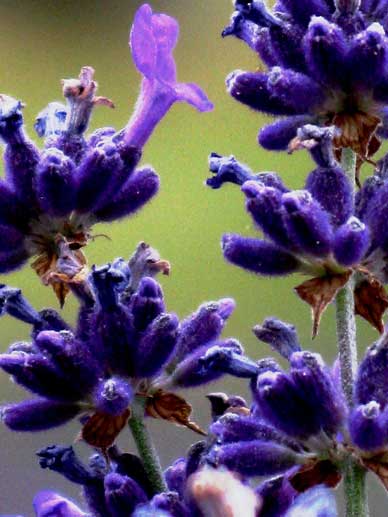

LAVANDULA ANGUSTIFOLIA ‘PACIFIC BLUE’ – FRESH & PEPPERY
In full flower and full grown Pacific Blue is a generous splayed bush to 75cm round, of compact cylindrical flower spikes about 7 – 8cm long. We regard Pacific Blue’s startling deep violet floral display our very special Christmas present as it reaches full flower usually around this auspicious day here in the Australian Alps and yes, while not making a habit of it, we have done a celebratory harvest on that day to mark the beginning of our flower season. While French in origin this cultivar was named and developed in New Zealand by Peter Smale of Crop and Food Research (V. McNaughton – Lavender the Growers Guide, 2000, Bloomings Books, Aust.) and has earned its place as one of our farm’s foundation cultivars both for its statue and beauty but also for its consistent yields of a very interesting lavender oil.
ESSENTIAL OIL
Interestingly our two New Zealand cultivars, Avice Hill and Pacific Blue, reverse each other’s balance in the key lavender compounds linalool and linalyl acetate. Pacific Blue is definitely a linalool chemotype consistently registering percentages between 36% and 41% of this compound with linalyl acetate in the low range between 18.67 – 27.55%. In fact the whole chemistry of this oil is skewed towards the alcohol compounds, linalool, lavandulol, borneol, octen-3-ol, α- terpineol, terpineol–4 –ol all together registering as high as 56% of the total oil chemistry. Unusually, for lavender oil, Pacific Blue is consistently very high in terpinen–4 –ol (between 9 and 10%) the key compound of Tea Tree Oil (Melaleuca alternifolia). All this works to intensify the monoterpenol character of the oil and at an aromatic level gives it a green and peppery herbaceous fragrance with undertones of rose leaf freshness thanks to higher than normal levels of b(E)-beta-farsenene (1.8 – 2.3%) and limonene/ ß-phellandrene (1.5 – 2.5%).
HYDROSOL
The hydrosol derived from the Pacific Blue cultivar has herbaceous peppery front notes and a green freshness which pushes the piquant honey notes typical of most angustifolia cultivars into a secondary role as a sweet undertow and finishing note. As with all our lavender hydrosols Pacific Blue comes off the still with a pH level well below 4.5.


TYPICAL PHYTOCHEMICAL PROFILE RANGE, L.A. PACIFIC BLUE 2005 – 2014
linalool 36.06 – 41.61 • linalyl acetate 18.67 – 27.55 • lavandulol 0.71 – 0. 93 • lavandulyl acetate 2.52 – 3.56• limonene/ ß-phellandrene 1.53 – 2.46 • octen -3-ol 0.28 – 0.54 • 1,8-cineole 0.27– 0.42 • cis-ß-ocimene 3.24 – 4.01• trans-ß-ocimene 1.40 – 2.18 • 3-octanone 1.08 – 2.60 • octen-3-yl acetate 0.42 – 0. 72 • geranyl acetate 0.27 – 0.49 • neryl acetate 0.14 -0. 25 • camphor 0.08 – 0.47 • borneol 0.38 – 1.19 • terpinen-4-ol 8.45 – 10.68 • α- terpineol 0.19 – 0.78 • ß – caryophyllene 1.11 – 1.67 • (E)-beta-farsenene 1.76 – 2.29 • α –santalene 0.96 – 1.17
